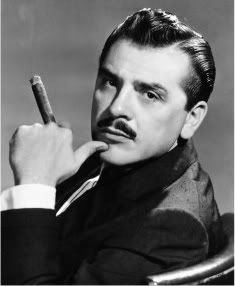 |
| Ernie Kovacs rarely appeared without a cigar. |
Time was, an elegant woman or dashing man was portrayed on-screen with a lit cigarette in hand. Wealth could be indicated by a long cigar, poverty or desperation by a short stub clenched in the teeth. Anxiety was telegraphed by a nervous flick of ashes from a tightly-clutched cigarette.
Everyone smoked.
This reflected a society in which many people smoked. I recall watching movies from a balcony seat, since my parents smoked, and that was where smokers were seated in the theater.
In one of the first smoking restrictions, smoking was prohibited for the patrons in movie theaters - but on-screen, cigarettes were still a frequent accessory to glamor and the good life.
As societal norms have changed, though, have the movies kept pace? That was the question addressed by a study done in 2005 by Dr. Karan Omidvari and others at St. Michael’s Medical Center in Newark, NJ. They recorded the smoking habits of five main characters in each of 447 movies made during the 1990s, including hits like Independence Day (with its celebratory cigars), and There’s Something About Mary.
The researchers excluded animated features and science fiction with settings other than Earth, because they aren't typically intended to represent reality. They also didn’t count as a smoker any character whose smoking was only depicted in a flashback or another scene that didn't occur “in the present, in the sense of the film.”
What they found about smoking in movies from that decade may surprise you. Only 21 percent of “good-guy” characters smoked, while 36 percent of their adversaries did. Omidvari reflected that it is good news that Hollywood tends to depict smokers as unsympathetic characters.
Overall, 48 percent of the movie smokers were portrayed as from a lower socioeconomic class, while 23 percent appeared middle-class. Only 11 percent of smokers could be identified as upper-class. (The remaining characters could not be assigned to any particular class.)
What they found about smoking in movies from that decade may surprise you. Only 21 percent of “good-guy” characters smoked, while 36 percent of their adversaries did. Omidvari reflected that it is good news that Hollywood tends to depict smokers as unsympathetic characters.
Overall, 48 percent of the movie smokers were portrayed as from a lower socioeconomic class, while 23 percent appeared middle-class. Only 11 percent of smokers could be identified as upper-class. (The remaining characters could not be assigned to any particular class.)
The study revealed that smokers in US movies are more likely to be villainous and poor than heroic or wealthy. Omidvari did note that in R-rated and independent films, main characters were more likely to smoke than they were in studio releases. In fact, in these films, smoking was more prevalant than it is in the US population as a whole.
I wonder how they would have counted Jim Carrey's manic character in The Mask? To quote Stanley Ipkiss, “SMO-kin’!”
No comments:
Post a Comment